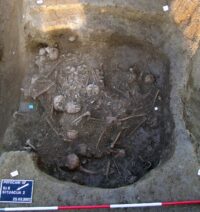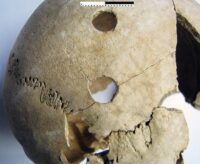 Genetic studies of prehistoric massacres have found instances connected to warfare (all male, likely died in battle), targeted executions of families, migrants in conflict with local groups and ritual killings for religious purposes. The massacre in the Copper Age burial in Potočani, Croatia, doesn’t fit any of these categories.
Genetic studies of prehistoric massacres have found instances connected to warfare (all male, likely died in battle), targeted executions of families, migrants in conflict with local groups and ritual killings for religious purposes. The massacre in the Copper Age burial in Potočani, Croatia, doesn’t fit any of these categories.
The mass grave was discovered during construction of a garage on private land in 2007. In a small pit about 6.5 feet in diameter and three feet deep, archaeologists unearthed the skeletal remains of 41 individuals. Many of the bones were comingled, some still articulated. Radiocarbon dating of the remains dated the burial to 4200 B.C. and some pottery fragments recovered from the pit identify the deceased as members of the Lasinja culture of the Middle Copper Age.
Researchers cleaned and documented the bones, recording age, sex and any evidence of trauma or illness. Of the 41 individuals, 20 were female, 21 male. There were 21 children with the youngest between two and five and the oldest between 11 and 17. Of the 20 adults, 14 were younger (18-25), five middle-aged (36-50) and one’s age could not be determined. They had good teeth and were generally in good health, aside from a case of meningitis and five of scurvy.
 A total of 28 perimortem injuries were found on 13 skulls. Most of those were from blunt force trauma, with a smaller numbers of stabbing and piercing wounds and cuts. The trauma was inflicted regardless of age or sex. Little boys and girls were struck just as the adults were. All 41 were buried at the same time, so while the remains only confirm violent death for 13 of them, it’s almost certain the others died by violence too, the marks of it just didn’t make it to the bones.
A total of 28 perimortem injuries were found on 13 skulls. Most of those were from blunt force trauma, with a smaller numbers of stabbing and piercing wounds and cuts. The trauma was inflicted regardless of age or sex. Little boys and girls were struck just as the adults were. All 41 were buried at the same time, so while the remains only confirm violent death for 13 of them, it’s almost certain the others died by violence too, the marks of it just didn’t make it to the bones.
The research team was able to extract ancient DNA from 38 of the 41 individuals from the Potočani mass grave. Genomic analysis found that they were a homogeneous community with predominantly Anatolian Neolithic ancestry and a soupcon (~9%) of Western European hunter-gatherer ancestry. They were not a close kinship group, however. Only 11 of the deceased were related to each other in four distinct lines: a young man with two daughters and his nephew, two young sisters with a young man who was a 3rd degree relative, a father and son, a boy with his paternal aunt or half-sister.
These results indicate a large and stable population (estimates based on the DNA data put it from 20,100–75,600 people at the time of the burial) was attacked indiscriminately. No families were deliberately targeted. It wasn’t a battle between two armed factions.
The study also considered the potential role of climate change in the mass burial event. When climate changes, resources such as water, vegetation — including feed for cattle and other livestock — and game animals become less predictable. Furthermore, hazards, such as unpredictable extreme weather, become more common.
“These factors tend to disrupt human lifeways, and groups sometimes try to take over others’ territories and resources,” [University of Wyoming anthropology professor James] Ahern explains. “Increases in population size cause groups to overextend their local resources and require expansion into other areas. Both climate change and population increase tend to cause social disruption and violent acts, such as what happened at Potočani, that become more common as groups come into conflict with each other.”
The study has been published in the journal PLOS One and can be read here.
maybe they were gypsies who stole from the wrong warlord
…Business as usual on the Balkans :no:
youtube.com/watch?v=c-WO73Dh7rY
———
PS: I wonder, how 6000 years ago those impressively perfect holes were inflicted, and just remembered that I have a potential relative, who was murdered in 1640 by “Croats”. At least they were referred to as “Croats” back then, but it could as well have been the Protestants (you never know, and I probably never will).
False, if you want to see the oldest and the most recent indiscriminate mass killings, follow Islam
Islam was founded in the 600s A.D. This long predates that.
…apparently, the terms for “necktie” from…
Albanian: kravatë ..down to..
Yiddish: קראַוואַט (kravat),
..originally were derived from those “Croats” as military unit and from dudes like this one:
upload.wikimedia.org/wikipedia/commons/0/0d/Kroatischer_Reiter_um_1630-1.JPG
cf.:
en.wikipedia.org/wiki/Croats_(military_unit)
en.wikipedia.org/wiki/Schwedentrunk
:hattip:
Speculative thinking much regarding the reason for their demise?
upload.wikimedia.org/wikipedia/commons/d/d2/Samotovac_earthenware_mace.jpg
commons.wikimedia.org/wiki/Category:Kameno_doba
No idea what “Kameno doba” is supposed to mean, and no date nor a place, but “Samotovac” (“Самотовца”) seems to be in what today is nearby Serbia, and if hard enough, that mace would really be just perfect for inflicting those perfect round holes :skull:
Very much later, i.e. 3K years later, in the Bronze Age, Homer lets us know about “Aksini”/ἀξίνη hatches and “Pelekys”/πέλεκυς axes (Iliad 15.707-712). From receiver’s point of view, they are both the same, as πελεκισμός=death by axe, while ἀξινόπληκτος=struck by an axe.
5K years ago, however, poor Ötzi already owned a copper axe.
——–
τοῦ περ δὴ περὶ νηὸς Ἀχαιοί τε Τρῶές τε
δῄουν ἀλλήλους αὐτοσχεδόν· οὐδ’ ἄρα τοί γε
τόξων ἀϊκὰς ἀμφὶς μένον οὐδ’ ἔτ’ ἀκόντων,
ἀλλ’ οἵ γ’ ἐγγύθεν ἱστάμενοι ἕνα θυμὸν ἔχοντες,
ὀξέσι δὴ πελέκεσσι καὶ ἀξίνῃσι μάχοντο
καὶ ξίφεσιν μεγάλοισι καὶ ἔγχεσιν ἀμφιγύοισι.
——–
“About his ship Achaeans and Trojans were slaying one another in close combat, nor did they longer hold aloof and thus endure the flight of arrows and darts, but standing man against man in oneness of heart, they fought with sharp battle-axes and hatchets, and with great swords and two-edged spears.”
Seems as if the ‘Good Old Days’ in the Neolithic ‘Linear Pottery culture’ were occasionally rather bloody :ohnoes:
cf.:
——
de.wikipedia.org/wiki/Massaker_von_Potočani (CR, apparently the one presented here)
de.wikipedia.org/wiki/Massaker_von_Kilianstädten (DE)
de.wikipedia.org/wiki/Massaker_von_Schletz (AT)
de.wikipedia.org/wiki/Grubenanlage_von_Herxheim (DE)
de.wikipedia.org/wiki/Massaker_von_Talheim (DE)
thefirstnews.com/article/secrets-of-neolithic-mass-grave-where-families-met-a-grizzly-end-revealed-5818 (PL)
——
…and certainly a few others, not included here.